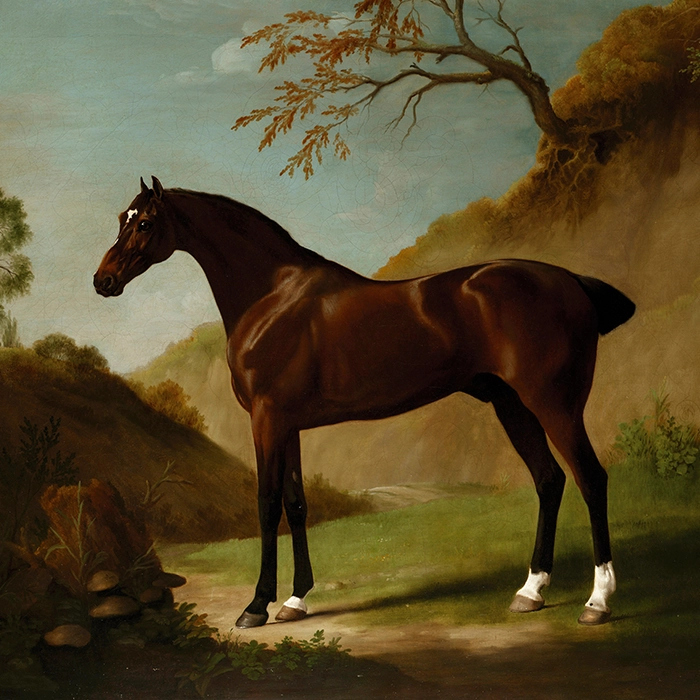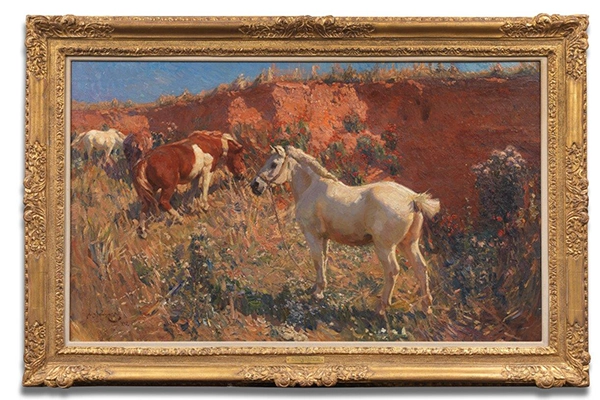20 March 2024
Equine art: Why two artists gallop ahead of the also-rans
4 minutes
Director and Head of Sale for Bonhams’ Victorian and 19th Century European Art Department, Peter Rees, highlights the collectors’ favourites in this specialist area of art
Arkel, Red Rum and Frankel are among the handful of British horse racing superstars –– but when it comes to the elite in equine art, bidders really get the bit between their teeth to secure paintings by two particular artists, George Stubbs (1724-1806) and Sir Alfred Munnings (1878–1959).
|
(Image: A dark bay thoroughbred in a landscape by George Stubbs (Liverpool 1724-1806 London), oil on canvas 101.7 x 127 cm. (40 x 50 in). Sold for 1,931,650. Credit Bonhams) |
Both artists lead from the front when it comes to prices for their work which have consistently risen over the last decade. This bucks the trend as the market for other equine artists’ work, such as John Frederick Herring, Cecil Aldin and Lionel Edwards, is not quite so buoyant and certainly not attracting the same interest as in this genre’s 1980s heyday. Munnings and Stubbs were both prolific artists who often accepted commissions from aristocratic patrons who wanted paintings of their best-loved thoroughbreds to hang on their walls. George Stubbs was classified in his lifetime as a sporting painter and was thereby excluded from full membership of the Royal Academy. Early clients for his sporting and racing paintings included founders of the Jockey Club and his work includes the portrait ‘Whistlejacket’ which can be seen in London’s National Gallery, and ‘Mares and Foals in a River Landscape’ in Tate Britain. In 2003, Bonhams fetched £1,931,650 for Stubbs’ painting ‘A dark bay thoroughbred in a landscape’ (Liverpool 1724-1806 London) oil on canvas 101.7 x 127 cm. (40 x 50 in). Sir Alfred Munnings was a keen horseman and bought a white mare so he could study equine anatomy and movement. At the Royal Academy, he derided Modern Art, but his seemingly effortless brushstrokes give a rather modern impression. Munnings was blind in his right eye so could not go into combat but served as a World War I war artist. His first painting on the Western Front was of war horse ‘Warrior’. The horse’s rider, Jack Seely, was a friend of Winston Churchill. |
In 2010, Bonhams auctioned Munnings’ beautiful mid-1930s painting ‘The Start at Newmarket’, which sold for a £524,000.
Our 19th Century and British Impressionist Art sale on September 27, 2023 features Munnings’ ‘The old gravel pit, Swainsthorpe, showing three ponies grazing in Norfolk. It was painted in 1907 and was displayed at the Royal Academy in 1908. The painting was mentioned in his autobiography, and it has not been seen on the market for 20 years, so we are anticipating huge interest with a guide price of £300,000-£500,000.
We always ensure a sensible guide price as it is quite easy to compare prices of other recent, similar works.
|
(Image: The old gravel pit, Swainsthorpe by Sir Alfred James Munnings, PRA, RWS (British, 1878-1959) |
While not everyone can enter the market by purchasing Munnings and Stubbs, very often we see equine art buyers starting out with bids for lesser-known artists, often buying in volume, and as their knowledge grows or tastes change they will often sell a few paintings to enable them to buy something of a higher value. At Bonhams, we are always available to discuss upcoming lots.
I always suggest that buyers should also visit art galleries including The Munnings Art Museum, in Dedham, near Colchester, in Essex which holds a significant collection of Sir Alfred Munnings’ work throughout eight rooms of his former home. Here visitors can take a close look at how Munnings approached painting horses with one room dedicated to his equine studies. A special exhibition, Munnings: Colour & Light, runs until October 22, 2023 (munningsmuseum.org.uk).
Meet Peter Rees
I found my way into the business in the old-fashioned way, starting as a porter, setting up auctions, carrying heavy furniture backwards upstairs and lotting up rooms full of smelly antique carpets. When I found an opening into the picture division I grabbed it and I have always loved the sheer variety of my particular discipline. There are thousands of artists and numerous different artistic movements and styles across Britain and Europe in the 19th and early 20th century. I genuinely encounter artists I have not seen before on a weekly basis.
My top tip? Never buy something you don’t like – it may be an investment but always be happy to have it hanging on your wall.
Insurance advice
If you have a fine art collection you should check it has the correct insurance cover. You don’t always need a stand-alone policy to insure artwork, but it shouldn’t be insured as “Contents”. Our recommendation is that any art in any form is insured under the “Art and Antiques” section of your policy. Ensure there is a good description of each item, with size and images.
We also recommend that you get an up-to-date valuation. Make sure the valuation is for insurance purposes and that documentation is kept in a safe, secure, but memorable place in the event of a claim. We have a panel of recommended valuation companies that can assist by not only valuing your pieces now, but by also giving you up-to-date valuations going forward. Some of the insurers we work with will give a 25 per cent or even 50 per cent uplift for three years following a valuation to protect policyholders from rising prices.
To speak to Howden about your insuring your art call 020 8256 4901 or email art.insurance@howdeninsurance.co.uk


